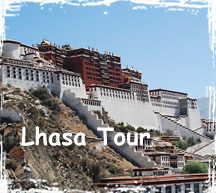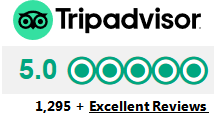Our Lhasa Trip
Tony,
Sorry for the delay in feedback. I thank you for all your prompt and quick replies to our needs and desires for the Lhasa tour that we took on March July 12-15,2007. You are very professional and provided what we had requested. The guide (Lucia Lee) in Lhasa was wonderful with very good English skills, a wonderful personality, and full of information. The driver was very friendly, careful and always helping. The jeep was very clean, and as requested there was no smoking.

Day 01( July 12,2007 ) Beijing - Lhasa by overnight train
Beijing 9:30pm for Lhasa
Early morning we went to the Badaling Great Wall,one of the 600 km section of the Great Wall surrounding Beijing. After lunch, we continued a visit to Dingling, one of the Ming Tombs, where 13 emperors were buried in Ming Dynasty. After dinner, transferred to Beijing West Station to take Train NO.T27 ( hard sleeper ) starting at 9:30PM for Lhasa.
The Beijing Lhasa Railway extends about 2525 miles across the heartland of the Middle Kingdom and the Tibetan Plateau. It is estimated that it has 675 tunnels and bridges. The top of the route is at 16,640-foot Tanggula Pass. I took the hard sleeper No.20 in Car 5 with just a fold-out map of China to keep me informed. Each car had an electronic sign showing the speed, altitude and next stop. I had meant to buy a soft sleeper. But it sold like a hot-cake, hard to get. In the black market, for each soft sleeper ticket, you had to pay extra RMB 1000!
In my compartment, the beds were stacked up like facing bunk beds across a table, with pressed cotton sheets, pillows and comforters. Each sleeper was equipped with a TV monitor and headset as well as oxygen canisters for those with altitude sickness. The curtained window at my elbow was spotlessly clean and slightly tinted. It was neat for a long-distance train compartment at least at the beginning of the long trip. My travel companions were two young American backpackers. They spent much of their time drinking beer in the dining car. I liked walking around in a pull-down seat in the corridor, where I watched the view passing by.
Day 02 ( July 13, 2007 ) On the train
8:00 Beakfast in the dining car
When it was time for breakfast, we came to the dining car for an unappetizing meal served on tin plates: potatoes, cabbage, greens, a slice of Spam, half a hard-boiled egg and more. The most people were subsisting on snacks, instant noodles or beer.
Xian 09:06
The train conductor said Xian was in sight. Next in China I will visit Xian, where the first emperor in China was buried. I was lucky enough to have a glimpse of the city due to the central location of the Xian Train Station, just in the downtown. I came out of my compartment and took some fresh air. The time for the Xian stop was 15 minutes.
Lanzhou 15:56
After a short nap, I just woke up for a short stop at Lanzhou Train Station. It seemed it was an ugly, polluted city. It is located in a narrow valley. The Yellow River passes through the city. It is one of the largest cities in the northeast. One of my companies on the car, told me that there was an famous attraction around Lanzhou - the Bingling Temple Caves.
Xining 19:04
We were nearing Xining, capital of Qinghai province. Xining is the capital of Qinghai province, and an important stopover for a visit to China's largest inland lake, Qinghaihu, a bird watchers paradise. It is a good starting pointing to come into Tibet from here.
Day 03( July 14,2007 ) Later afternoon arriving at Lhasa
Golmud 06:20
We was woken up the train conductor to get out of the train and see the Golmud Railway Station. The amazing raiway from Golmud to Lhasa is 1142 km long. On 15 October 2005 the final section of the rail was finished on the banks of the Lhasa River. The Age of the train in Tibet dawned on July 01 2006.
Tanggula Pass came and went, almost indistinguishable from the rest of the high country. Most of the way, we followed the Qinghai-Tibet Highway, completed 53 years ago. We stopped rarely and only briefly.
Nagqu 16:51
It was terrific, treeless Tibetan Plateau, where villagers gazed at the passing train and yaks bolted off the tracks. Up here, the curvature of the Earth seemed almost apparent to the naked eye, and every few minutes another nameless range of snow-capped peaks with glaciers streaming down their sides appeared on the horizon.
Lhasa 20:58
Whole daytime in the train enjoying the views outside. Arriving at Lhasa at 8:58PM. Met and transferred to my hotel in Lhasa - Lhasa Hotel. I was free to get accustomed to the Tibetan climate and altitude. My new local guide in Lhasa was called Marry Ma, a volunteer tour guide from Shanghai. She said every year the Chinese government would send hundreds of English speaking tour guides to Tibet from other provinces and cities. All these tour guides would get some supplements from the government.
Day 04 ( July 15, 2007 ) Lhasa
Touring the Potala Palace:
The Potala palace was built over 400 years ago as the Dali Lama's residence. And the palace contains over 9000 rooms. The Potala stands over Lhasa, dominating the skyline. It was one of the greatest achievements of Eastern architecture. There are in fact two linked but distinct palaces. The White Palace was the seat of the government and bureacracy while the Red Palace was for religious purposes. It was the Fifth who constructed the Red Palace, though he died before it was completed.
My localguide led me to the Potala Palace with a long walk of the steep Marpo Ri hill. The Potala is now an official Chinese musuem with tight control. I begins my visit near the top of the complex, winding my way through the Red Palace before seeing the Dalai Lama's old quarters. There are some very important and impressive chortens, thankas, statues, thrones, shrines. Sadly speaking, much of the Palace is still off-limits and one always thinks what is being hidden inside or behind.
The Potala is livened up by the devoted Tibetan pilgrims who shuffle through the various shrines murmuring Buddhist mantras and prostrating themselves in front of the anything representative of the Dalai Lama. It was pretty cool to walk through the Dalai Lama's living quarters, imagining his day-to-day life of meditation and consultation with government ministers and the occasional social visit from his brother and mother.
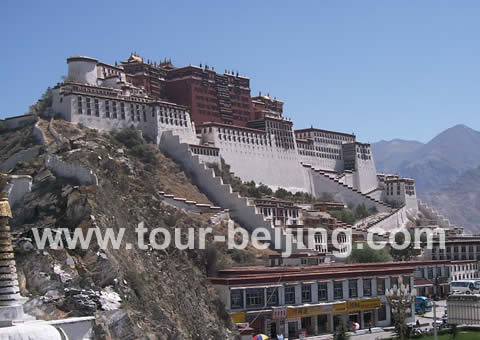
The Potala palace
Touring the Jokhang Temple and the Barkhor Street:
Jokhang Monastery, is situated in downtown Lhasa. It is a Buddhist hall for Tibetan Buddhists and a symbol of unity between the Tibetan and Han peoples. The Hall of Sakyamuni is the most important in the monastery. The statue attracts a great numberof worshippers every day. A lot of pilgrim were gathering in front of the gate worshipping. Some of them came out of their home half year ago, because they use a traditional worship way- kowtow to come here that mean their whole body would bended over the earth. Enter the temple, only one way you can walk, it’s clockwise direction. All the people were holding the butter jug and butter light enter to do worship. After one hour we had finished in the temple, and decided to do the circuit just to watch the pilgrims do their thing. I joined the Tibetan pilgrims on the Barkhor Circuit. The circuit is a path around the temple, and walking around it is a ritual for many pilgrims as the Jokhang is one of the most important buddhist temples in Tibet. Barkhor Street is the oldest street in Lhasa, as well as the most Tibetan. Constructed in the 7th century, It is the circular street that pilgrims either walk or crawl around the Jokhang Temple. Only about 1/2 mile long, it is crammed with traditional Tibetan houses, narrow lanes and vendors all along the street and Barkhor Square trying to sell something...anything.
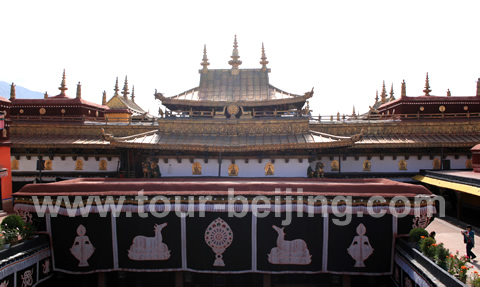
The Jokhang Temple
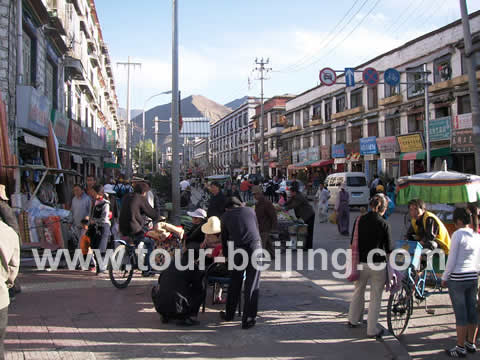
The Barkhor Street
Day 05 ( July 16, 2007 ) Lhasa
Touring the Sera Monastery:
After lunch, then take the jeep up to the Sera Monastery, north of Lhasa.
It was pretty amazing as it seemed it was less crowded here. After visiting most of the chapels we could hear the sound of horns blowing so we decided to investigate. We walked up to one of the higher chapels and found a group of pilgrims gathering around. Many of the Sera monks gather at one of the temple courtyards at 3:00 in the afternoon to practice their debating skills. It all seems a bit of a tourist attraction really, but they look like they are having fun and they really get into it - lots of clapping, hand slapping and even a bit of pushing and shoving.
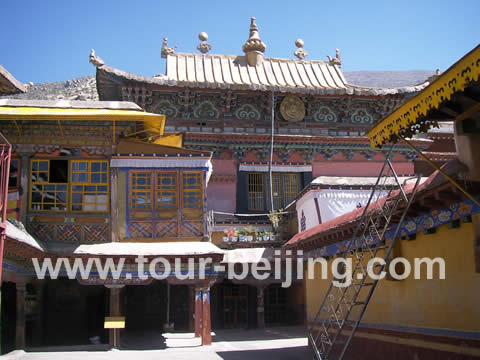
The Sera Monastery
Touing the Norbulingka Park:
Located in the western suburbs of Lhasa, Norbulingka Park was built in the middle of the 18th century during the reign of the 7th Dalai Lama and served as the Summer Palace of Dalai Lamas where they handle political affairs, practiced religious activities and spent holidays. Traditionally the Dalai Lamas would leave the Potala Palace every spring and spend the summer in Norbulingka.
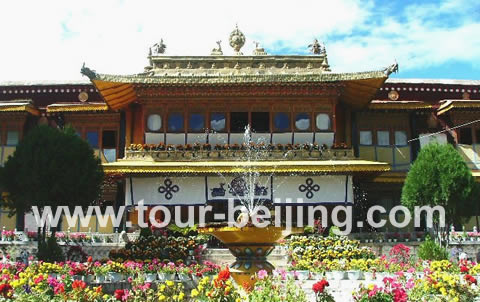
The Norbulingka Park
Touring Drepung Monastery:
Drepung Monastery is located in west of Lhasa under Mt. Gambo Utse. it was built in 1416, it is regarded as one of the largest monasteries in the six principle monasteries of Gelu Sect in China. Drepung Monastery used to be the living palace of Dalai Lamas before the reconstruction of Potala palace.
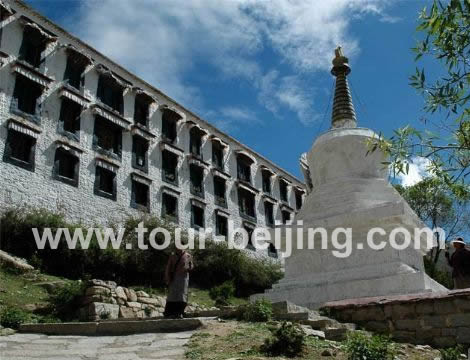
Drepung Monastery
Day 06 ( July 16, 2007 ): Lhasa-Shanghai Flight
This morning I visited the Tibet Museum. The Tibet Museum lies just in the southeast corner of Norbulingka Park of Lhasa city. It has an area of about 23,500 square meters with the exhibition area of about 10,450 square meters. The museum is equipped with modern facilities to maintain the quality service for visitors and safety and efficient administration of the museum itself. Here exhibits are introduced in Japanese, English, Tibetan, and Chinese, to serve all the visitors from all over the world.
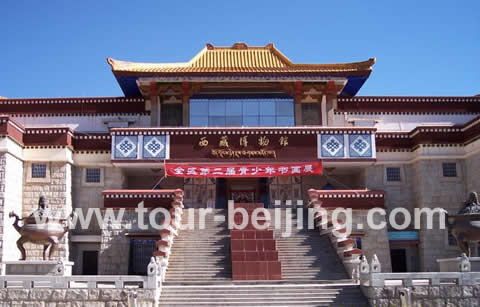
The Tibet Museum
After lunch, I ws transferred to the airport for Shanghai.
Questions & Answers:

